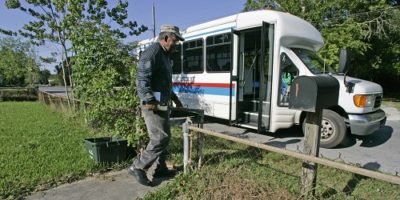We welcome guest blogger Steve Yaffe of Yaffe Mobility Consulting & Project Manager for NADTC’s Implementation Grants. Steve most recently served as Transit Services Manager for the Arlington County (VA) Department of Environmental Services – Transportation Division, where he oversaw planning and operations for Arlington Transit (ART) fixed-route transit as well as Specialized Transit for Arlington Residents (STAR).
2019 Transportation Research Board
International Conference on Demand Responsive
and Innovative Transportation Services
Trends in Demand Response Service
Steve Yaffe co-chaired the 2019 Transportation Research Board (TRB) International Conference on Demand Responsive and Innovative Transportation Services April 15-17, 2019, in Baltimore, Maryland. Steve and co-chair Mark Mindorff, Executive Director of DARTS Transit in Hamilton, Ontario, hosted 160 private and public sector ride providers, analysts, advocates, and consultants to discuss the progress made in providing mobility options that respond to the needs of those who cannot or choose not to drive alone.
NADTC is pleased to provide these “notes from the field” as an overview of what innovations and practices are trending in the area of demand response transportation. Be sure to scroll down to learn about plans to meet to continue the discussion on this ever-evolving topic.
Conference Highlights
Older adults are benefitting from the flux of innovative techniques used to provide mobility to the general public. A widening range of shared-ride options are becoming more widely available in suburban and rural areas. Many of these include neighborhood circulators used to reach nearby stores and other destinations as well as transit hubs for regional rail and bus connections.
The 63 conference presentations profiled:
- Accessibility, equity, and sustainability considerations for inclusive service design, fare payment, and marketing.
- Business models and payment strategies that will promote and integrate new mobility services while respecting the privacy of personal data and proprietary software.
- How the legal and regulatory systems governing transit and procurement practices help or hinder development of demand response transportation.
- New Federal Transit Administration structure for data-driven decisions and performance evaluation to promote innovative technologies, partnerships, and infrastructure supportive of economic growth, productivity, safety and quality of life.
- Novel ways to connect passengers and transit.
- Potential of transit partnerships with healthcare and social service agencies to efficiently provide rides.
- Potential framework for and basic requirements of transit partnerships with automated vehicle providers.
- Structure and success of a variety of demand-response systems around the world.
- Transit Data Metrics and Planning Techniques that support communications within mobility partnerships, performance management, and bench-marking of demand response transportation services.
Conference Presentations
Links to most of the presentations can be found by clicking on the presentation title in the online agenda.
Demand Response Partnerships
One clear takeaway from the conference is that there are a wide variety of new demand response partnerships in North America. These partnerships vary in many aspects, highlighted below.
Who’s leading the effort
- Public sponsors include transit authorities or municipalities.
- Ride providers may be a transit authority, software provider, or a third-party contractor.
- Partnerships differ as to whether they were created after consultation with stakeholders and community engagement where all of the major demographic groups were welcomed, included and involved to identify the needs to be addressed.
- Partnerships may be created with clear public sector objectives and key performance indicators to measure service quality (reliability and equitable access) as well as efficiency.
- Partnerships vary in terms of the degree of flexibility in the partnership and the structure of the demand response service to successfully respond to challenges.
Contracts
- Projects may be short-term pilot projects or long-term contracts to amortize costs.
- Terms of contracts vary regarding whether the contract enables consultation, cooperation, and sharing of risk between project partners.
How rides are booked and provided
- Rides may be booked by a private sector app or by a modified public sector app which feeds into the private sector app.
- Subsidized rides may be allowed to any destination within the demand response service area or to only one or a few to boost productivity.
- A free transfer to the transit system may or may not be provided.
- Differences in service level in terms of whether riders who use wheelchairs can expect a comparable wait time for a ride.
Payment
- Fare charged for the demand response service may differ compared to the transit fare.
- Providers vary on whether cash is accepted as the fare (providing access to the unbanked).
- Systems vary as to whether fare media for the demand response service and transit system are integrated (e.g., an EZ-Pass style account).
The variety of partnerships, contracts, and levels of service provided mean that the conversation is not over when it comes to understanding the depth of demand response transportation operations! With this in mind, future conferences are in the works to continue the conversation.
Future Conferences
TRB is fostering mobility strategies through sponsored research, on-going conversations, and this demand response conference, the third on this topic since 2014. Research and discussions promote a structured marketplace open to innovation through public-private partnerships that support efficient and effective mobility for all, including those who prefer not to drive and those who are unable to drive themselves.
The conversation will continue at TRB’s 99th Annual Meeting in January 2020. The next Demand Responsive Conference is tentatively scheduled for September 2021 in Texas. More information will be shared at the American Public Transportation Association (APTA) Mobility Conference in Louisville in May 2019.
The 2019 Demand Response Conference is the fourth meeting on this topic hosted by TRB. The first was in Monterey, California, in the 1990s. The second was held in Monterey in 2014, the third in Breckenridge, Colorado, in 2016. Because Demand Response transit is in a revolutionary phase, we need to keep meeting!
For questions or more information, contact Steve Yaffe at yaffe@ymobility.info.

Leave a Reply